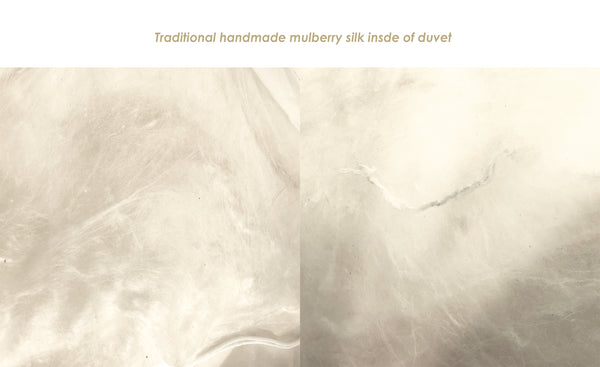How to distinguish different types of silk baiting layer
Posted by Layla Vu on
Mulberry leaves are the only food for silkworms. It is very important to grow mulberry trees in an organic environment. The smell of any kind of insecticide or even perfume can cause deaths of silkworms.
Only around 5% of mulberry silk cocoon is dupion. Dupion is more elastic and more fluffy than other types of silk cocoon. The characteristics of the dupion silk make it the most suitable material for our silk duvet. It takes around 750 silk cocoons to make 500g of silk floss.
There are six steps to make clearwater silk wadding, each step is handcrafted by our artisans. The silk sericin protein can naturally repel allergy-inducing pests and mould. For the highest benefit of our health, we keep the silk wadding in their original forms. No bleach or chemicals were used to whiten them.
The art of stretching the silk layer is based on the tacit understanding of 4 artisans. The balance of stretching force will result in the leveling of each silk layer. With hand-stretched silk layered on top of each other is creates a breathable grid design, it allows extremely fluffy and airy silk inside the duvet. There is no need to fix a sewing thread in the middle of the duvet to keep the silk in place. We only stitched duvet on the outer edges.
A truly masterpiece begins with exceptional raw materials, curated with patience and expertise to craft handmade luxury silk duvet that reflects the quality of silk and the traditional silk culture.
silk wadding already listed as a tribute to the emperor. It’s mainly used to fill winter coat or quilt/duvet.
he craft of Clearwater silk wadding is required time, patience and carefulness, it’s mainly passed from mother to daughter or daughter-in-law, from generation to generation. This heritage craftsmanship and skills at risk of dying. Now, it's only carried by a small group of artisans in eastern China.
Together, we are working to keep this timeless treasures alive.
3 types of silk duvet
Industrial silk duvet filled with industrial short fibre silk wadding
- Fast and larget production;
- Added chemicals to clean silk;
- No check pocket or small check pocket on the duvet;
- Use residual of mulberry silk, wild silk, or mix with artificial fibers;
- Box stitches, circle stitches or other kinds of stitches on the duvet, for fixed the short fibre silk wadding inside, it looks like other duvets.

Hand-stitched silk duvet layered with industrial mulberry silk wadding
- Use abolished and defective silk cocoons;
- Use chemicals to clean silk and make it fluffy and soft;
- Layered with a big piece of industrial silk wadding, less layer, stretchable;
- Can find rougher texture inside;
- Hand-stitched, a check pocket on the duvet.


Hand-stitched silk duvet layered with traditional handmade mulberry silk wadding
- Slow and low production, no chemicals used, lasts for more than 20 years;
- Can find the edge of the handmade silk pocket inside of duvet;
- Silk in original appearance, the fiber is smooth, soft, less white and clean than industrial silk, kind to skin;
- Hand-stitched only on the outer edges of the duvet cover so that you can check pocket on the duvet.


Luala Silk only use the finest silk floss to make baiting layer. Discover our non bleach 100% natural silk duvet
- Tags: tips
